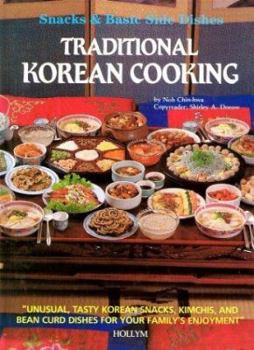Traditional Korean Cooking
75 traditional Korean recipes including desserts, bean curd dishes, basic side dishes and a variety of kimchis, a spicy fermented pickle have been chosen from the best of Korean cooking. These popular... This description may be from another edition of this product.
Format:Hardcover
Language:English
ISBN:0930878485
ISBN13:9780930878481
Release Date:January 1985
Publisher:Weatherhill
Length:78 Pages
Weight:1.17 lbs.
Dimensions:0.5" x 7.6" x 10.4"
Customer Reviews
1 rating
Unusual Format, good culinary content, great pics
Published by Thriftbooks.com User , 18 years ago
The three glossy, Golden Book styled Korean cookbooks by Noh Chin-hwa and Copyreader Shirley A. Dorow form a rather oddly titled collection of pretty good recipes covering the width and breadth of Korean cuisine. One really wishes these three volumes had been published as a single volume, especially as there is no index spanning the three volumes. These books are entitled `Healthful Korean Cooking, Meats & Poultry', `Low-Fat Korean Cooking Fish, shellfish & Vegetables', and `Traditional Korean Cooking, Snacks and Basic Side Dishes'. Aside from the very non-European way of organizing these topics, the most difficult thing may be the mislabelling of various Korean techniques. Classic Korean barbecue is really a high heat fast cooking method, much more like grilling than smoke-based slow cooking barbecue. It's most distinguishing feature is that it is done on the tabletop on a grill very similar to the Japanese Hibachi. In other places, the name `broiling' is given to what is essentially another instance of grilling. While I have eaten several meals at a Korean restaurant, I have never reviewed other books on Korean cuisine, so I can only judge this as if I were judging a book on French or Italian or Southern American cuisine. One very dramatic feature of all three volumes is the fact that each and every recipe is accompanied with a series of very good color pictures illustrating the main steps in the procedure. This is in addition to a larger picture of the completed dish. Another very good aspect of the photographs in these books is that all the dishes are plated on similarly colored and shaped plates, so the essential difference from photo to photo is in the food and not in the crockery. The photographer really gets a chance to do his stuff with the double page pics of typical table settings. While it does me little good, I liked the fact that each dish is clearly named with an English name, a Korean name in English script, and the Korean name in Korean pictographs. For Korean speaking readers, I suspect this is a good thing. The one thing I found most annoying about the way the recipes were written is in the fact that the list of ingredients is not in tabular form. That is, the amount and name of the first ingredient begins at the beginning of the first line, followed immediately by the amount and name of the second ingredient without a line break, if there is room remaining on the first line. Ultimately, the most annoying thing about this collection is that the division of dishes between the volumes makes little sense to a Western cook, there is no combined index, and so much material in the introductions, glossaries, and table setting pics is duplicated in all three books. And yet, until I review any more Korean cookbooks, these volumes' strengths outweigh its weaknesses if you are an amateur cook and really want to reproduce dishes from your local Korean eatery. I would prefer seeing a more general approach similar to the many exc





